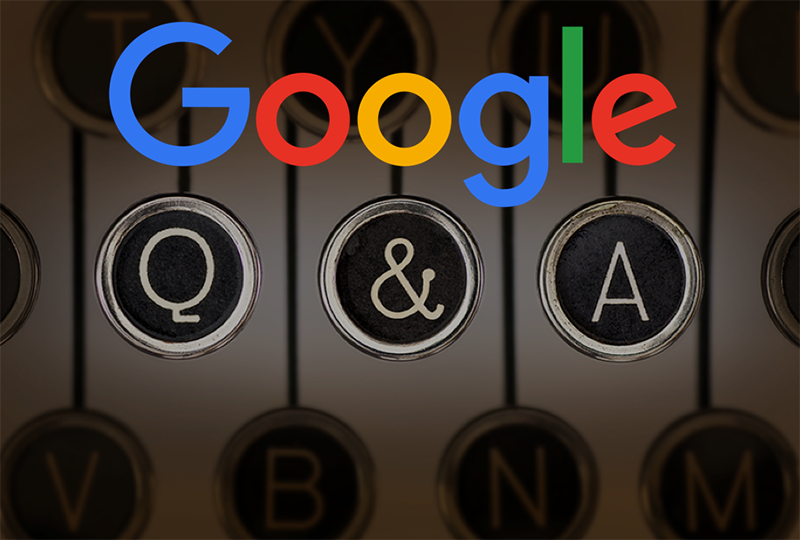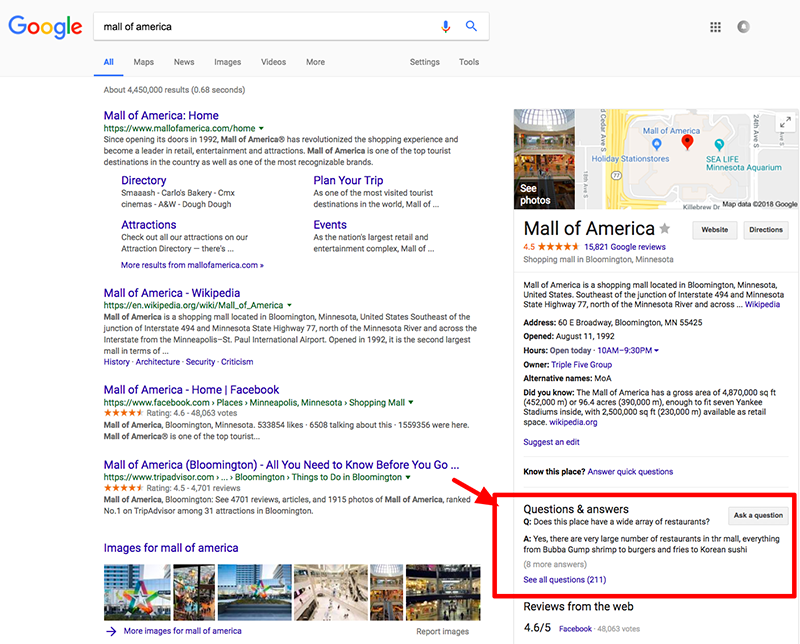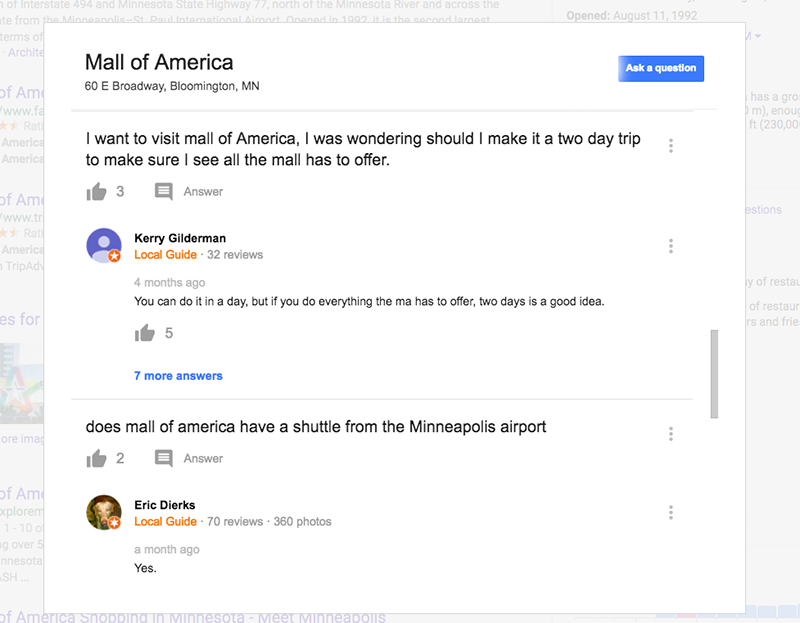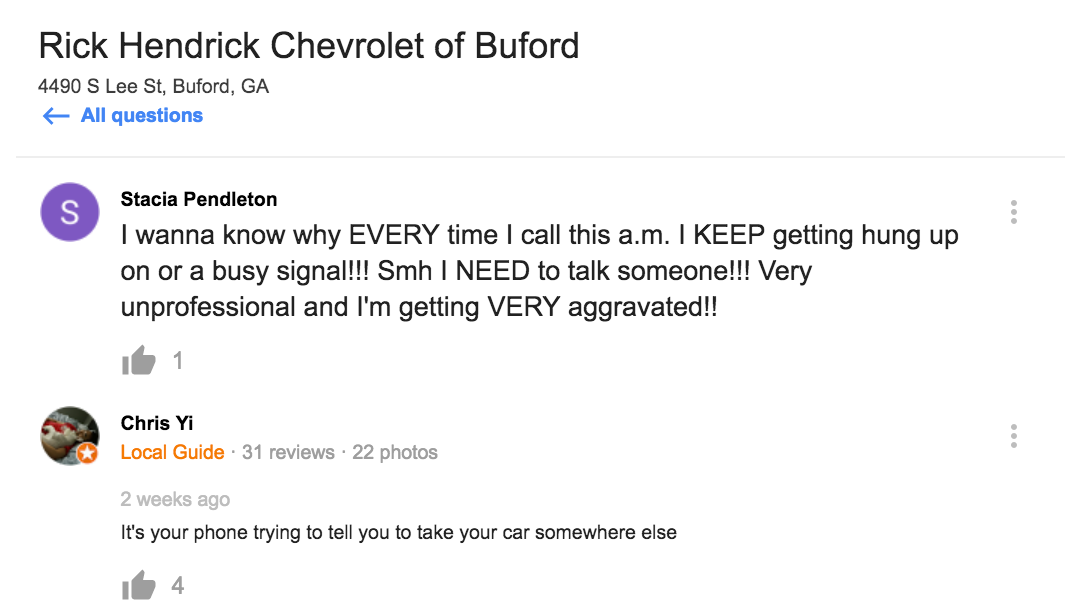This is the first post in a three part series on Google Q & A. Part 2 is a Big Guide To Google Q&A and the 3rd part is on how to manage it.
Google has been on a mission to make Google search results the only place consumers need to stop online before choosing a business. They have steadily increased the content of the Local Knowledge Panels and reduced traffic to your website while continuing to send you leads.
It’s incredibly important to note that the last few years have shown a shift with your local brand story at Google being as much about your reputation as it is about your rank.
It is as much about your ability to convert convert users at Google as it is about whether you rank first or second or third. And the brand image you convey at Google that leads to these conversions is heavily influenced by user generated content of reviews and photos at both Google and from around the web.

Google Q&A – A New Feature In Your Local Search Results
Just when you thought you had learned how to interact with your new landlord, they add a new and unpredictable reputation clause to your contract about what can show on “your” page: Google Questions and Answers (Q & A).
Google introduced local Questions and Answers (aka Google Q & A) last August, first in mobile SERPS only and then on desktop search months later. These are user and business generated questions and answers that are shown with your local listing either in your Knowledge Panel or the Local Finder.
Here is a desktop example of where the new feature appears:
In the example above for Mall of America you can see that Google will tease one of the questions in the panel, with the rest of the questions and their answers viewable after you click the “See all questions” link.
Because it was initially mobile only it flew under most folk’s radar. With the rollout to the desktop in late November and the increasing levels of consumer use, it is becoming apparent that brands, agencies and small businesses all need to pay attention to this new local vector for a brand conversation.
The core of the feature is one that has been prevalent on sites like TripAdvisor and Amazon for years thus making it’s format understandable and easy to use for consumers.
It has become clear to many that Q & A will likely have a significant impact on your local brand.
How Does Google Q&A Work?
Here is a look at the feature and it’s options.
- It is a simple FAQ product that is attached to your local business information at Google.
- Both consumers and the business can ask questions
- Both consumers and businesses can answer questions
- Anyone can “vote” (clicking the thumbs up icon) for a question and/or an answer, providing a method to crowd source the value of either
- Any question with at least one vote can show on the front page of your brand search Knowledge Panel
- Any answer to that question with at least one vote can also show on the Knowledge Panel
- Other questions and their answers show behind the See all questions (10) link on the Knowledge Panel
- These questions are ordered by the number of “Thumbs Up” up-votes that each has received.
- The question with the most votes will show directly on the Panel.
- Google recently introduced new guidelines for User Generated Content on Maps that applies to reviews AND Q & A
- Questions and answers can both be reported for violations of those guidelines
What Are The Implications of Google Q&A?
Like any user generated content it has potential to both burnish or to damage the brand. When a location story goes viral, like we saw with Bedlam Coffee in Seattle, it can become a new reputation attack vector.
The simplistic voting system lends itself to abuses by bad actors, competitors and others looking to game the system.
Usually though, since it is occurring at a location specific level, the most likely brand problems can be more insidious and less obvious that your brand is being tarnished.
Here is an example of a question/answer I discovered in my research:
Q: Why are there still drug addicts and theives still working in this building and why is sandra covering for them? We found out.everybody in the building with thee exception of 1 or 2 people is on something. It doesn’t bother us that you all get high when you’re off the clock but during work hours? … You all are terrible. You are breaking the law in more ways than one…you will not silence the residents of p
Ignoring Q & A Is Not An Option
With the advent of the internet, online reviews, social media and increasing influence of the consumers, brands have learned how to engage in the on-going conversations constructively and to monitor and intercede when appropriate. But with Google Q & A and the popularity of Google for local discovery, every local business needs to begin to develop tactics for this new pathway for customer discussions.
Where as Facebook could ruin a brand in one fell swoop, Google Questions and Answers might be more akin to death by a thousand cuts.
Like wise if you engage with the product constructively and if happy customers interact with the system then we have seen incredibly positive brand advocacy taking place.
For example with Barbara Oliver Jewelry, we saw that when she sent happy customers to her Google brand page to leave reviews, many also answered her questions in ways that enhanced her brand.
More Content Right In The Results – Good or Bad
Google’s goal for the product is to provide potential clients with nuanced information about a business’s product or services. In the ideal world, a client can ask a legitimate question and receive a thoughtful and detailed response. And if things work out, the next client looking for the same service will be instantly gratified and give the business a call. With as little as one thumbs up up-vote, that question and answer can appear in the main Google search results for your brand.
But like any social environment, thing can go south and the impact on your brand can be significant.
Like any new social environment on the net, Q & A can be intimidating. How can you manage it let alone monitor it for multiple locations? How can you cope with one more place “you have to be”?
Have no fear, we will get to that. Part 2 is The Big Guide To Google Q & A so you can understand further how it works, what’s at stake and more.






Comments are closed.